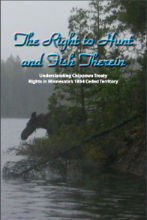About 1854 Treaty Authority
Purpose
Mission Statement
 “The 1854 Treaty Authority shall provide an Inter-Tribal natural resource program to ensure that the rights secured to member Indian tribes by treaties of the United States to hunt, fish and gather within the 1854 Ceded Territory shall be protected, preserved, and enhanced for the benefit of present and future member Indian tribes in a manner consistent with the character of such rights, through provision of services”.
“The 1854 Treaty Authority shall provide an Inter-Tribal natural resource program to ensure that the rights secured to member Indian tribes by treaties of the United States to hunt, fish and gather within the 1854 Ceded Territory shall be protected, preserved, and enhanced for the benefit of present and future member Indian tribes in a manner consistent with the character of such rights, through provision of services”.
Organizational Goals
- Provide an organization capable of delivering PROGRAMS to its’ qualified participants.
- Protect, preserve, and enhance the hunting, fishing and gathering RIGHTS of the Grand Portage and Bois Forte bands of the Lake Superior Chippewa in the 1854 Treaty area.
- Protect, preserve, and enhance the trust RESOURCES of the 1854 Treaty area.
- Preserve CULTURE by fostering interest, participation and understanding the traditions and practices that are integral to the Ojibwe way of life.
So Who Are We?
The 1854 Treaty Authority is an inter-tribal natural resource management organization that protects and implements the off-reservation hunting, fishing and gathering rights for the Grand Portage and Bois Forte bands in the lands ceded to the United States government under the Treaty of La Pointe, 1854.
Read "Our Story"
"And such of them as reside in the territory hereby ceded, shall have the right to hunt and fish therein, until otherwise ordered by the President"
-Article 11, Treaty with the Chippewa, 1854
History
-
1854
September 30th, the Chippewa of Lake Superior entered into a treaty with the United States whereby the Chippewa ceded to the United States ownership of their lands in what is now called Minnesota (northeastern portion). These lands are referred to as the 1854 Ceded Territory (a.k.a. 1854 Treaty Area).
-
1985
The Grand Portage band filed suit in U.S. District Court seeking a declaratory judgment that the 1854 Treaty reserved the band’s right to hunt and fish in the ceded territory free of state regulation. The other bands that signed the treaty and resided in the territory (Fond du Lac & Bois Forte) subsequently joined the lawsuit.
-
1988
The State of Minnesota and the three bands entered into an agreement to resolve the suit. Key elements included; the Bands regulate member activities, a cross-deputization for enforcement, and the establishment of a judicial services division.
-
1988
The Tri-Band Authority was established to implement the agreement.
-
1989
The Fond du Lac band withdrew from the agreement.
-
1989
The Tri-Band Authority became the 1854 Authority and continued to implement the agreement for the Grand Portage and Bois Forte band.
-
2006
The 1854 Authority changed its’ name to the 1854 Treaty Authority to better reflect and represent its’ actual identity.
-
2024
The 1854 Treaty Authority continues to implement the agreement for the Grand Portage and Bois Forte bands.
Structure
Structure
The 1854 Treaty Authority currently employs fifteen (15) full-time employees and consists of an Administrative Division, a Resource Management Division, Education and Outreach Division, and a Conservation Enforcement Division.
Governing Authority
The Treaty Authority is governed by a ten (10) member Board of Directors which consists of the duly elected officials of the Grand Portage and Bois Forte Tribal Councils. The “Board” meets bi-monthly to set and establish policy, ensure fiduciary responsibility, and ensure the mission of the organization is implemented.